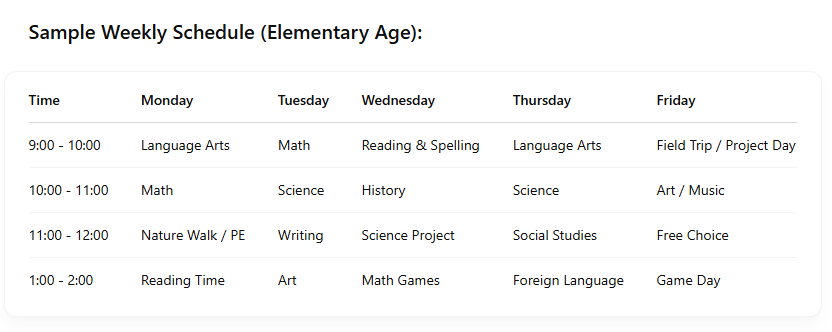Some of the links on this website are affiliate links, which means that if you click on them and make a purchase, I may earn a small commission at no additional cost to you. I only promote products and services that will add value to my readers. Thank you for supporting our work.
Homeschooling, a choice that is gaining popularity among families, offers a unique flexibility to customize your children’s educational experiences. Whether you are considering homeschooling for the first time or have already made the decision, embarking on this academic journey can be exciting and challenging. The key is to remember that you have the power to shape your child’s learning experience.
The good news is that you don’t need to plan every detail meticulously. This guide on how to start homeschooling will serve as your roadmap, outlining the essential steps and key considerations necessary to embark on your homeschooling journey with confidence and enthusiasm. You can create a vibrant and engaging learning experience tailored to your child with the right tools and insights.
Understanding Your Motivation
Before diving into the logistics, taking a step back and understanding why you’re choosing to homeschool is helpful. Parents come to homeschooling for many reasons:
- A child’s unique learning style or special needs
- Desire for a safer or more nurturing learning environment
- Frustration with traditional school systems
- Religious or philosophical beliefs
- The ability to travel or move frequently
- More time to build strong family bonds
Identifying your motivation helps shape your homeschooling philosophy and keeps you grounded when challenges arise. Write down your reasons and revisit them throughout your journey as a source of encouragement and guidance.
Research Your Local Laws
One of the first steps in your homeschooling journey should be to research the laws in your local area. Homeschooling laws can vary significantly from one place to another, so understanding your local legal requirements is crucial for a smooth start.
In the United States, each state sets its own homeschooling rules. Some require minimal oversight, while others may ask for:
- Official notice of intent to homeschool
- Submission of a curriculum or learning plan
- Annual standardized testing or evaluations
- Maintenance of student records and portfolios
To ensure compliance from day one, check your state’s Department of Education website or consult with national organizations such as HSLDA, which can provide legal advice and support for homeschooling families.

Create a Homeschooling Plan
Once you understand the legal side, it’s time to build a personalized homeschool plan. This plan doesn’t have to be a rigid blueprint but a general outline to guide your year.
Start by defining:
- Your educational philosophy (e.g., child-led, structured, faith-based)
- Core subjects to cover (math, science, language arts, history/social studies)
- Goals and learning objectives for each child
- A rough daily or weekly schedule
- Methods of evaluation (quizzes, projects, portfolios)
Think of your homeschooling plan as a living document. It will evolve with your homeschooling experience.
Choose an Educational Method
One of the most empowering aspects of homeschooling is the ability to select an educational approach that aligns with your child’s unique learning style and teaching preferences. Here are some of the most popular methodologies:
1. Classical Education: This time-honored approach divides learning into three stages:
- Grammar: Where foundational knowledge is built.
- Logic: Focuses on critical thinking and reasoning.
- Rhetoric: Where students learn to express their thoughts clearly and effectively through debate and writing.
This method emphasizes building knowledge and developing intellectual skills.
2. Montessori Approach: Dr. Maria Montessori’s method encourages independence and resilience through hands-on learning and child-directed exploration in a carefully prepared environment. Children can choose their activities from various options, promoting self-motivation and a love of learning.
3. Charlotte Mason Method: Rooted in the belief that education should inspire and cultivate a child’s character, this method emphasizes rich literature, nature study, narration, and the formation of good habits. It promotes a broad cultural education that nurtures the mind and the spirit.
4. Unschooling: This approach is characterized by a high degree of flexibility and is driven by the child’s interests. Rather than adhering to a fixed curriculum, children learn through real-life experiences, personal hobbies, and spontaneous exploration, allowing them to engage with topics that ignite their passion.
5. Online or Virtual Schooling: For families seeking a balance between traditional rigor and the flexibility of homeschooling, online or virtual schooling offers a structured curriculum delivered through digital platforms. This method combines the benefits of remote learning with access to certified teachers and resources, allowing for a more guided educational experience while being home-based.
Remember, you don’t have to restrict yourself to just one educational methodology. Many families succeed by adopting an eclectic approach, blending elements from various methods to create a tailored learning experience that meets their child’s needs and circumstances. By fostering an enriching, adaptable educational environment, you can truly support your child’s growth and development meaningfully.
Gather Resources
The next step is finding the right materials. Depending on your chosen method, your curriculum may come as a complete package, or you might piece it together from different sources.
Resources may include:
- Textbooks and workbooks
- Online programs and apps (e.g., Time4Learning, Khan Academy)
- Educational websites
- Reading lists and literature guides
- Manipulatives and learning games
- Printable worksheets and planners
- Library books and community classes
Also, don’t underestimate the value of local resources like museums, science centers, and homeschool co-ops. For instance, you can plan a field trip to a museum to supplement your history lessons or join a science class at a local science center to enhance your science curriculum.

Create Your Learning Environment
You don’t need a classroom to homeschool successfully. What’s more important is a space that encourages focus, creativity, and consistency.
Here are a few tips:
- Choose a quiet, comfortable space with good lighting
- Use bins, shelves, or file folders to keep materials organized
- Hang up visual schedules or calendars
- Make room for creative art supplies, music, or nature kits
A flexible, well-stocked space helps set the tone for productive learning but remember: learning can happen on the couch, in the yard, or on the go.
Implement a Routine
While homeschooling offers flexibility, a daily routine helps maintain structure and momentum.
Your schedule might include:
- Morning circle or read-aloud time
- Core subjects in the morning (when the focus is highest)
- Outdoor play or physical activity
- Afternoon project work or science experiments
- Quiet reading or independent learning blocks
Block scheduling, loop scheduling (where subjects are rotated in a loop, ensuring each subject is covered regularly), or time-based routines can all work. Find what fits your lifestyle. Remember to build in time for breaks, snacks, and mental resets.

Connect with the Homeschooling Community: You’re Not Alone
One of the most rewarding aspects of homeschooling is the sense of community that it can provide. Contrary to popular belief, homeschooling is not isolating. There is a vibrant and supportive community of homeschooling families online and in most local areas, ready to offer peer support, curriculum advice, and encouragement during challenging times.
Benefits of joining a group include:
- Peer support and mentorship
- Curriculum advice and recommendations
- Co-op classes or field trips
- Group activities, clubs, or sports
- Encouragement during challenging times
Search for Homeschooling Facebook groups or Meetup.com, or check with your library or community center to find groups in your area.
Assess Progress Regularly
You can keep track of your child’s educational journey and developmental progress by using regular assessments that extend beyond conventional tests. By focusing on real-world evaluations, you’ll gain valuable insight into their growing skills and knowledge in practical, everyday situations.
Here are a few methods:
- End-of-unit reviews or quizzes
- Journals and writing samples
- Oral narration or discussion
- Projects, artwork, or presentations
- Portfolio of completed work
Some states may require standardized testing, while others leave it optional. Either way, periodic reflection helps you make informed decisions and celebrate milestones.
Stay Flexible and Adapt
Even with the best plans, there will be days when things don’t go as expected, and that’s okay. Flexibility is one of the greatest gifts of homeschooling.
Pay attention to what works and what doesn’t:
- Is your child struggling with a curriculum? Try a different format.
- Are mornings tough? Shift the routine to start later.
- Feeling burnt out? Take a week off or switch to interest-based learning.
Give yourself grace and the freedom to pivot when necessary. Homeschooling is a journey, not a race, and every family’s path will look a little different.
Conclusion
Starting your homeschooling journey can feel exhilarating yet daunting, but it presents a unique chance to enrich your child’s educational experience. Identifying your motivations, be it personalized learning, flexible scheduling, or stronger family bonds, lays a solid foundation for your adventure. Staying updated on local legal requirements, including curriculum choices, assessment standards, and documentation, is vital. Understanding these details helps you navigate the complexities of homeschooling confidently.
Creating a flexible plan tailored to your child’s learning style, interests, and pace is essential. Incorporate diverse teaching methods, resources, and activities to meet their needs. Utilize hands-on projects, digital tools, outdoor explorations, and community engagement to cultivate a dynamic learning environment that inspires curiosity and a love for learning. Avoid overwhelming yourself- take steps at your own pace. Focus on your goals, adjust when needed, and seek support from other homeschooling families, local co-ops, or online groups during challenges. Celebrate small victories and enjoy this rewarding learning journey alongside your child; it’s a growth opportunity for both of you.

